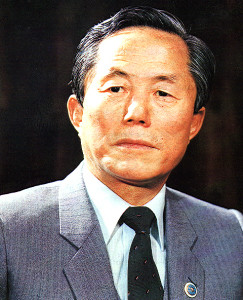Taekwon-Do History
 On April 11th, 1955, the name Taekwon-Do was officially adopted for the martial art General Choi Hong Hi had developed using elements of the ancient Korean martial art of Taek Kyon and of Shotokan karate, a martial art he had learned while studying in Japan.
On April 11th, 1955, the name Taekwon-Do was officially adopted for the martial art General Choi Hong Hi had developed using elements of the ancient Korean martial art of Taek Kyon and of Shotokan karate, a martial art he had learned while studying in Japan.
The philosophical values and the goals of Taekwon-Do are firmly rooted in the traditional moral culture of the Orient. On the technical side, defensive and offensive tactics are based on principles of physics, particularly Newton’s Law, which explains how to generate maximum force by increasing speed and mass during the execution of a movement.
Wanting to share the results of his philosophical reflections and his technical experiments, General Choi planned and wrote a unique reference work, the Encyclopedia of Taekwon-Do. In its fifteen volumes, he explained in detail the rules and practices of this art.
Always striving for excellence, General Choi presented Taekwon-Do as in a state of continuous evolution, open to changes that would improve its effectiveness. He wrote that anyone who believes he has fully discharged his duty will soon perish. Likewise, any undertaking that is perceived to have reached its objectives is likely to lose momentum, stagnate, and die.
Since the beginning, Taekwon-Do has never stopped evolving, driven by the strong will and a lot of hard work by its Founder. The leaders of the ITF today also recognize the need to evolve and they are equally passionate about the future of the organization.
The Founder
General Choi Hong Hi was born on November 9th, 1918, in the Hwa Dae Myong Chun District of Korea.
At the age of twelve he started to study Taek Kyon, an ancient Korean method of fighting with the feet. Later, when he was studying in Japan, he met a Karate teacher who helped him earn his first degree Black Belt in less than two years. He then intensified his training, striving to earn his second degree. Around the same time, he started teaching.
Conscripted into the Japanese army during World War II, he was posted to Pyongyang where he was imprisoned. Wanting to maintain his good physical and mental health during his imprisonment, he practiced karate, alone at first, then by teaching it to the staff of the prison and the other prisoners.
Becoming an officer in the new Korean Army after the end of the war, he continued to teach his martial art to his soldiers as well as to American soldiers serving in Korea.
His beliefs and his vision of a different approach to teaching martial arts led General Choi to combine elements of Taek Kyon and Karate techniques to develop a modern martial art. He called it Tae Kwon Do, which means “the way of the feet and the hands”, and this name was officially adopted on April 11th, 1955.
In 1959, General Choi was named President of the Korean Taekwon-Do Association. Seven years later, on March 22nd,1966, he created the International Taekwon-Do Federation (ITF). As the Founder of Taekwon-Do and President of the ITF, he had the ability to share his art with students everywhere. Today, Taekwon-Do training is available around the world.
After a life dedicated to the development of Taekwon-Do, a modern martial art based on traditional values, philosophy, and training, General Choi, Founder of Taekwon-Do and President of the International Taekwon-Do Federation, died of cancer on June 15th, 2002, in the country of his birth.
General Choi Hong Hi, Founder and President of the International Taekwon-Do Federation died on June 15th, 2002, in Pyongyang, People’s Democratic Republic of Korea.
On April 11th, 1955, a special board of masters, historians, and other important members of Korean society held a meeting. Their purpose was to coordinate the various “kwans” (schools) and select a name for the newly-organized Korean style martial art. After reviewing several different names for the new style, they chose the name submitted by General Choi Hong Hi. That name was “Tae Kwon Do”.
General Choi is recognized around the world as the Father of Taekwon-Do and the Founder of the International Taekwon-Do Federation (ITF) and he created the ITF system that we know today.

